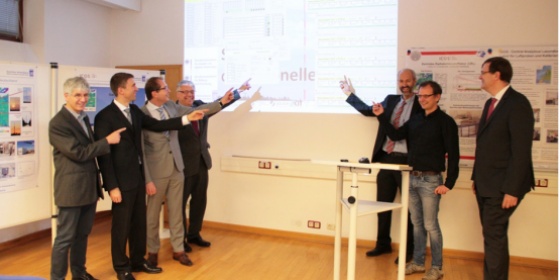
Alexander Dobrindt, German Federal Minister for Transport and Digital Infrastructure, and Stefan Müller, Secretary of State in the Federal Ministry of Education and Science visited the Atmosphere Observatory Hohenpeißenberg of the German Weather Service on 5th December 2016 and marked the start of ICOS Germany operational phase. They remotely started Hohenpeißenberg atmospheric station which is a 340 m tall tower located at Gartow, near Dannenberg (Elbe), about 100 km North-West of Berlin. It is the fourth atmosphere station in the German ICOS network which will be extended to nine stations during the year 2017. The new station will be remotely controlled from the Hohenpeißenberg Observatory.
The already existing four atmosphere stations as well as 15 ecosystem stations, three ship lines and two fixed ocean stations were constructed with funding from the German Federal Ministry of Education (BMBF) which in addition to the national observation network also funded the construction of the ICOS Central Analytical Laboratories. During the ceremony, Secretary of State Stefan Müller said: "By investing into the ICOS we have given a political signal for the international climate policy: The obtained data are an important base to verify our measures to reduce fossil fuel emissions. ICOS provides a fundamental contribution to the global climate agreement."
German national atmosphere network and the Central Analytical Laboratories are now transferred to the Federal Ministry of Transport and Digital Infrastructure (BMVI) which is also responsible for the German Weather Service. The BMVI funding will include the next construction phase with five new atmosphere stations, the continuous operation of the atmosphere network and the permanent operation of the Central Analytical Laboratories at the Max-Planck Institute for Biogeochemistry in Jena and the Institute for Environmental Physics of the University of Heidelberg.
"We are today starting the operational phase of one of the most innovative networks for greenhouse gas observations in the world," said Minister Alexander Dobrindt at the Hohenpeißenberg launch. " With this network we will observe the exchange of greenhouse gases between the atmosphere, oceans and land surfaces. We also will estimate how much CO2 is generated by fossil fuel combustion and how big natural fluxes are. With this knowledge we can improve our measures for climate change mitigation," concluded Minister Dobrindt.
During the ceremony, ICOS ERIC Director General Werner Kutsch introduced the ICOS European Research Infrastructure and its potentials to generate information through data model integration. He thanked the two ministries for their financial and administrative support that enabled the excellent start of ICOS. He finalized his speech with a wish: "Since science and technology has also the requirements to ICOS in supporting politics after the Paris Agreement, we need permanent innovation and we hope this will be further supported."
Gerhard Adrian, President of the German Weather Service also connected ICOS to the framework of long-term weather observations since the Hohenpeißenberg Observatory holds the longest meteorological data set in Germany since 1781 and shows clearly the changing climate. He also metioned that the Observatory is one of the core stations of the Global Atmosphere Watch Program of the World Meteorological Organisation and holds a 50 years record of ozone measurements.